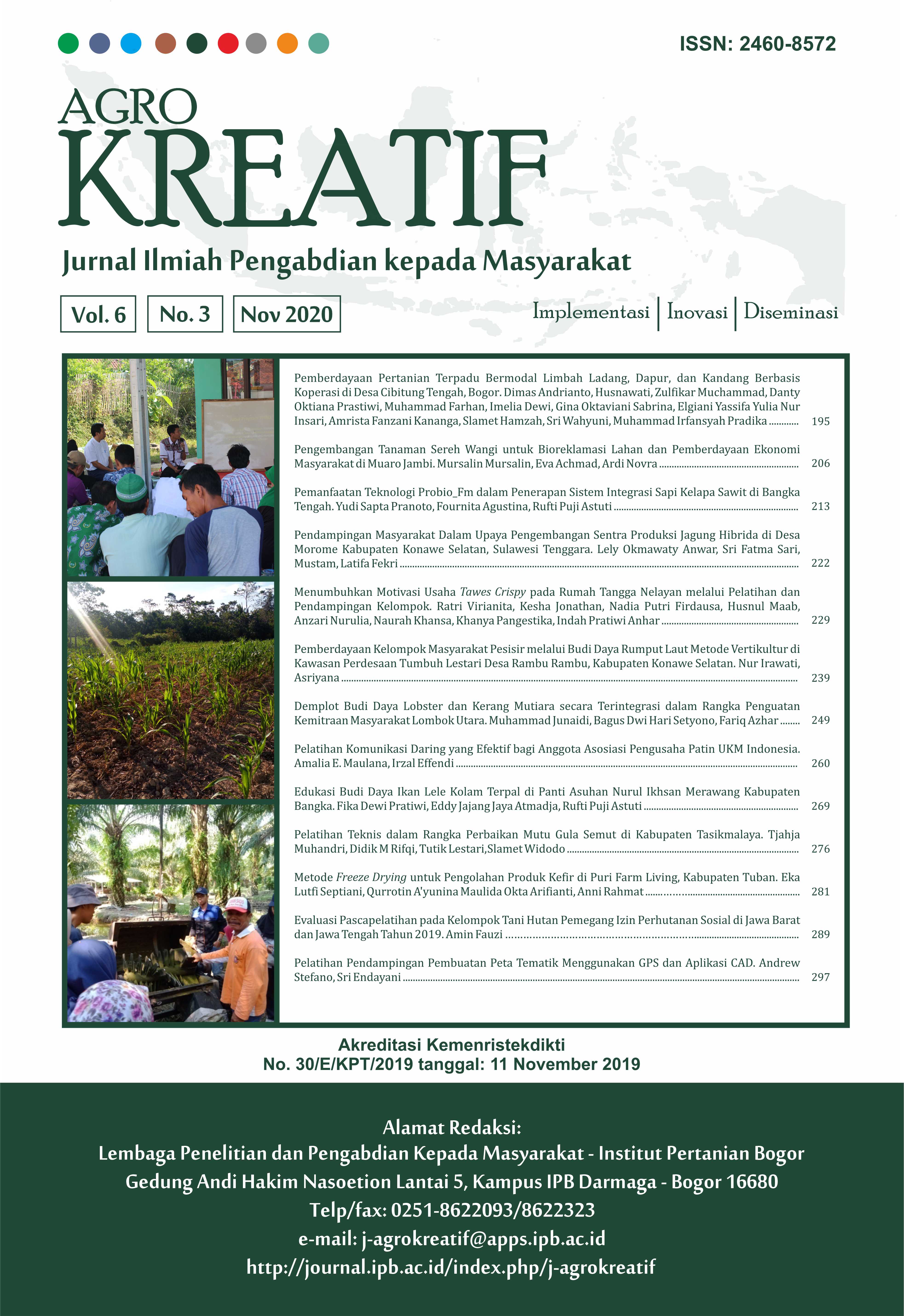Pengembangan Tanaman Sereh Wangi untuk Bioreklamasi Lahan dan Pemberdayaan Ekonomi Masyarakat di Muaro Jambi
Abstract
Degraded land due to brick industry, piling material, and coal mining activities are widely covered the area of Kebon IX Village, Sungai Gelam Subdistrict, Muaro Jambi District. This service activity was aimed at encouraging collective action by the village community of Kebun IX to apply citronella cultivation and processing technology in order to rehabilitate their land as well as develop productive economic businesses as a substitute for their old businesses that were not environmentally friendly. The method used was the combination of Participatory Rural Appraisal (PRA) and collective action model in promotion strategy and technology adoption. Through counseling, training and demonstration plots, four types of integrated businesses, including cultivation, processing and utilization of citronella by-product, have been successfully developed in Kebon IX Village. Citronella plants at aged 6‒8 months produced leaves at a price of IDR 500/kg and after 3 months can be harvested again. One clump of citronella plants can produce 1.5 kg at the first harvest and increase to 2.0 kg after the next harvest. One hectare of land can contain 1000‒1500 clumps of citronella plants. Citronella plant soil costs IDR 250,000/L, the residue of the distillation can be used as animal feed (IDR 150/kg) or used as trichocompost (IDR 1,200/kg). Trichocompost is also needed as organic fertilizer for the continuity of citronella cultivation. The integration of citronella plants cultivation and processing industry has a positive impact on land reclamation efforts as well as to empower the community's economy.
Downloads
References
Achmad E, Mursalin, Novra A. 2017. Desain model pembelajaran “green knowledge“ berbasis “green technology“ pada lahan terdegradasi akibat aktivitas galian timbunan bandara dan industri batubata rakyat. [Laporan Penelitian]. DP2M Kemenristek DIKTI.
Achmad E, Mursalin, Novra A. 2018. Rendemen minyak sereh wangi (Cymbopogon nardus L) yang dibudidayakan di lahan terdegradasi akibat aktivitas galian timbunan bandara. Dalam: Prosiding Seminar Nasional Teknopreneur Universitas Pasir Pengaraian. 1(1): 143–150. Riau (ID), Rokan Hulu, 31 Juli 2018. https://doi.org/10.32524/ jksp.v1i1.343
Anwar A, Nugraha, Nasution A, Amaranti R. 2016. Teknologi penyulingan minyak sereh wangi skala kecil dan menengah di Jawa Barat. Teknoin. 22(9): 664–672. https://doi.org/10.20885/teknoin.vol22.iss9.art4
Asyerem FSJ. 2011. Pemanfaatan agen hayati trichoderma spp dan bakteri selulotik untuk pengomposan Ageratum conyzoi-desvar Hirtum (Lam), Tithonia diversifolia (Hamsley) A. Gray dan ampas sagu sebagai pupuk organik pada cabai merah (Capsicum AnnuumL.). [Tesis]. Bogor (ID): Institut Pertanian Bogor.
Bestari RT. 2019. Rancangan alat penyuling minyak atsiri berdasarkan kriteria quality function deployment (QFD) dan House of quality (HOQ). [Skripsi]. Jambi (ID): Universitas Jambi.
Feriyanto YE, Sipahutar PJ, Mahfud, Prihatini P. 2013. Pengambilan minyak atsiri dari daun dan batang serai wangi (Cymbopogon winterianus) menggunakan metode distilasi uap dan air dengan pemanasan microwave. Pomits. 2(1): 93–97.
Litbang Pertanian. 2012. Tanaman Atsiri untuk Konservasi dan Sumber Pendapatan Petani. [Internet]. [diunduh 20 Mei 2017]; tersedia pada: http://www.litbang.pertanian.go.id/artikel/one/154/pdf/Tanaman%20Atsiri%20untuk%20Konservasi%20dan%20Sumber%20Pendapatan%20Petani.pdf.
Nurhayu A, Warda. 2018. Pengaruh pemberian limbah sereh wangi hasil penyulingan minyak atsiri sebagai pakan ternak terhadap penampilan induk sapi bali. Biocelebes. 12(3): 30‒40.
Pertiwi DS, Gunawan A, Avicenna JM. 2003. Peningkatan kualitas minyak sereh wangi dengan distilasi kukus. Dalam: Prosiding Seminar Nasional Teknologi Proses Kimia V UI Jakarta. Jakarta (ID), 26 Maret 2003.
Sukamto, Djazuli M, Suheryadi D. 2011. Seraiwangi (Cymbopogon nardus L) sebagai penghasil minyak atsiri, tanaman konservasi dan pakan ternak: Inovasi Teknologi Mendukung Peningkatan Nilai Tambah, Daya Saing dan Ekspor Perkebunan. Dalam: Prosiding Seminar Nasional Inovasi Perkebunan. Bogor (ID): Puslitbangbun. hlm. 175‒180
This work is licensed under a Creative Commons Attribution-NonCommercial 4.0 International License.



















